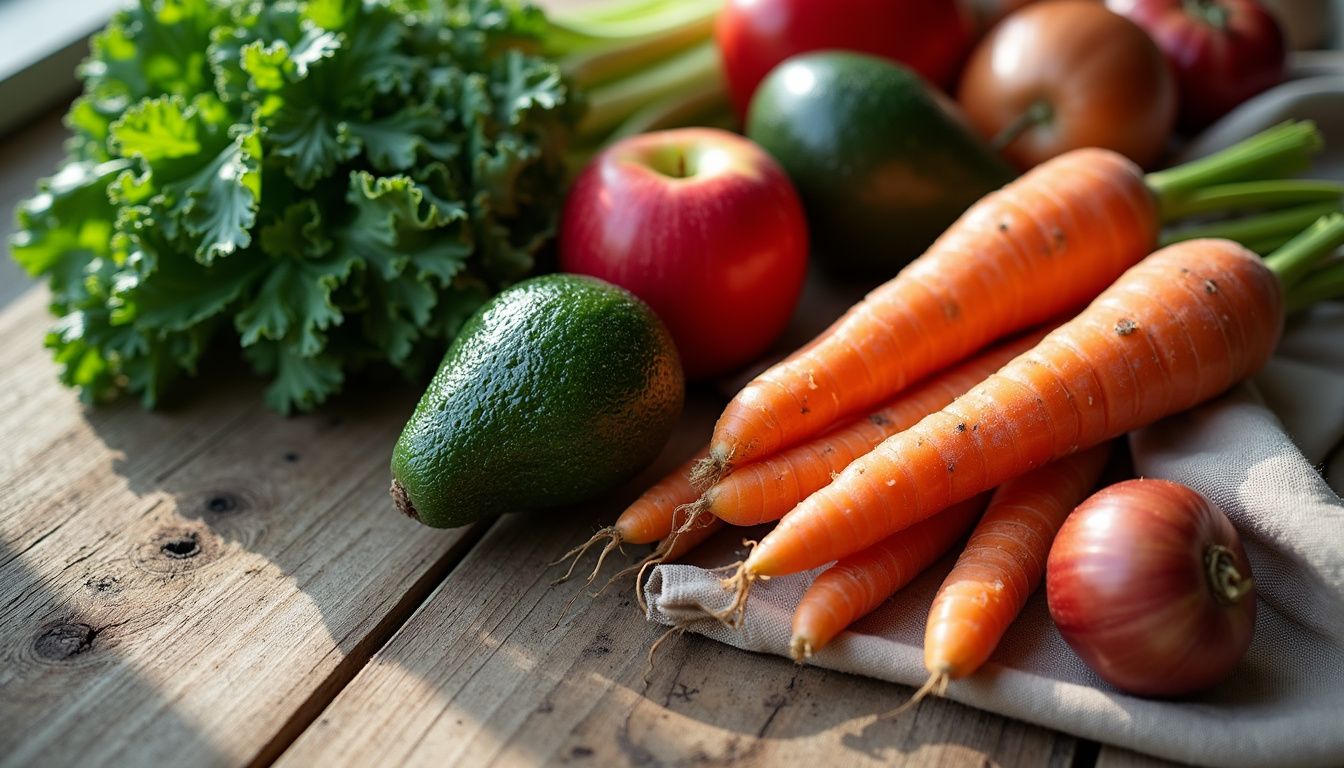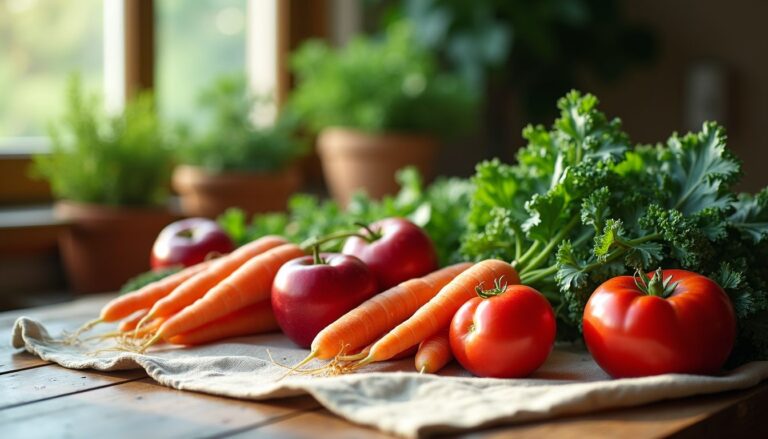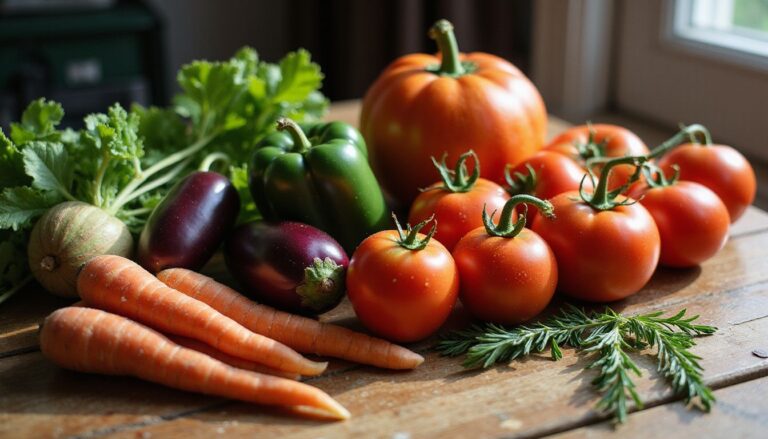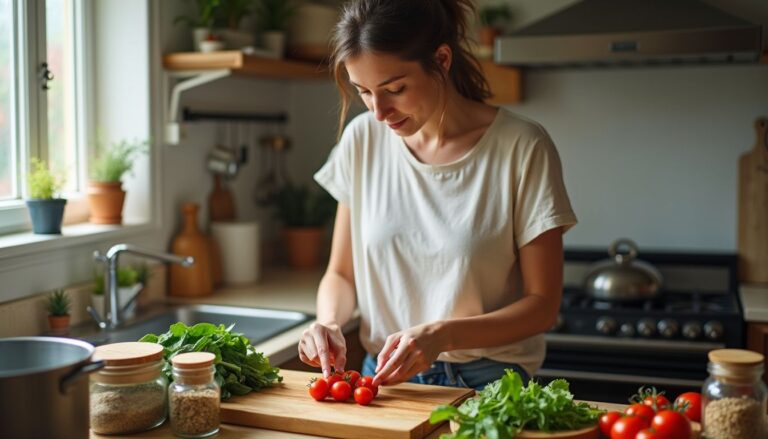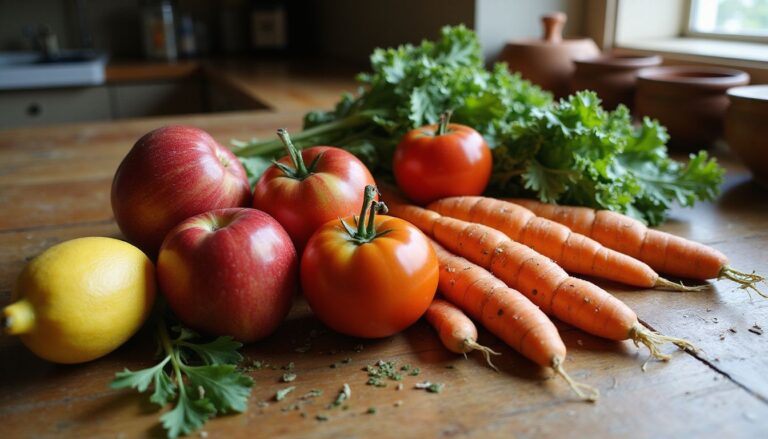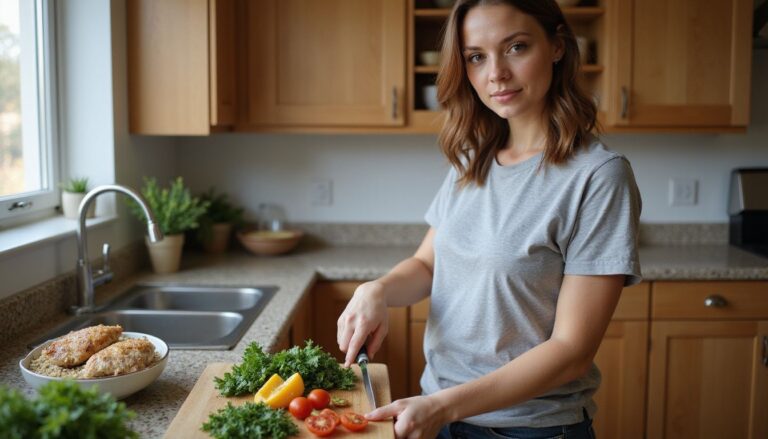Top 10 Best Low Calorie Foods To Keep You Feeling Full And Satisfied
Our Nutrition Assistant AI Suite will transform your body. You will lose fat, get toned, and build muscle. Gain confidence and optimal health.
If you feel hungry while cutting calories, you are not alone. Many low-calorie foods are rich in fiber and have high water content, which helps you feel full with fewer calories and less fat or sugar. Choosing the right low-calorie foods can make healthy eating simpler and help you maintain a healthy weight.
This guide highlights practical swaps and nutrient-dense picks that keep you satisfied. You will see how small changes in your eating plan add up to better energy, fewer cravings, and steady progress.
Keep reading to learn which tasty foods help keep hunger in check all day.
Key Takeaways
- Fiber-rich foods such as apples, about 3 grams per cup, and black beans, about 7 grams per half cup, slow digestion and help control hunger.
- High water foods including cucumbers, 8 calories per half cup, and watermelon, 46 calories per cup, add volume for very few calories.
- Lean protein sources like skinless chicken breast, about 128 calories per serving, eggs, edamame with 17 grams protein per cup, and nonfat Greek yogurt promote satiety.
- Leafy greens such as spinach, 7 calories per cup, kale, and Swiss chard provide vitamins and minerals while keeping meals light.
- Whole grains like oatmeal, 83 calories per half cup cooked, quinoa, and air-popped popcorn offer steady energy through fiber.
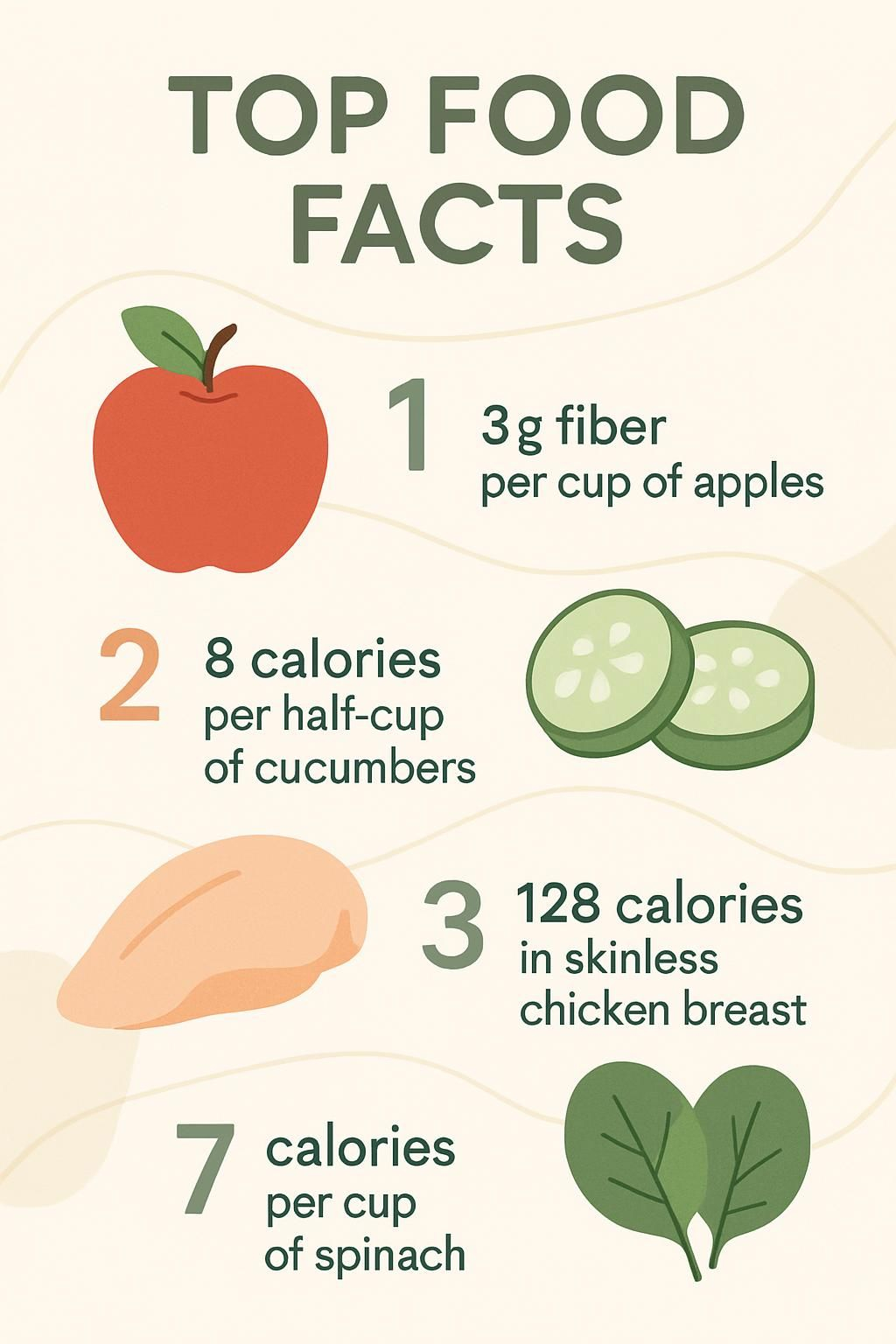
What Are the Key Factors That Make Foods Low Calorie and Filling?
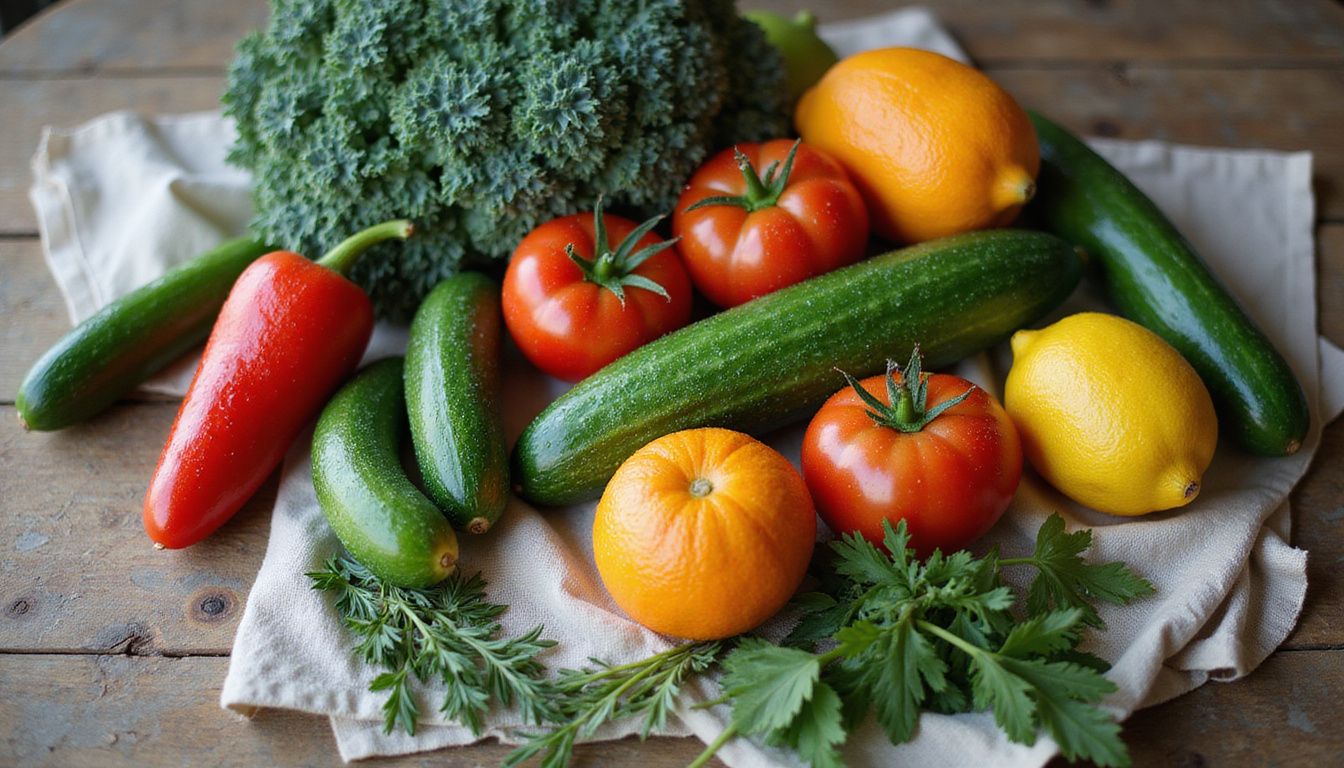
Foods that are low in calories yet filling usually share three traits. They are high in water, rich in fiber, or packed with lean protein. Fiber is the part of plants your body cannot digest. It slows digestion, which helps you feel full longer. Protein supports muscles and also boosts satiety. Water adds volume with almost no calories, which means a bigger plate for less energy.
How Does High Water Content Help You Feel Full?
Water adds bulk without adding many calories. Water-rich foods like watermelon, about 46 calories per cup, and cucumbers, only 8 calories per half cup, help you feel full while keeping calories low. Iceberg lettuce has about 8 calories per cup, yet it increases meal size and satisfaction. Celery offers only 17 calories per cup and pairs well with a protein-rich dip for longer fullness.
Build salads and snacks around high water vegetables such as lettuce, cucumbers, and celery. You can eat larger portions compared with higher fat or sugary foods and still stay within your calorie target. Many people find that swapping calorie-dense snacks for water-rich fruits and vegetables reduces cravings and supports steady weight loss.
Why Is Fiber Important for Satiety?
Fiber slows digestion, which steadies blood sugar and keeps you satisfied. Apples deliver nearly 3 grams of fiber per cup and make a smart snack between meals. Oatmeal supplies soluble fiber, which gels in the gut and helps you feel full, at about 83 calories per half cup cooked. Black beans add both fiber and protein, about 109 calories per half cup, for reliable staying power.
Vegetables like broccoli, about 54 calories per cup cooked, and Brussels sprouts, around 70 calories per cup, are strong sources of dietary fiber. Strawberries contain pectin, a gel-like fiber that slows stomach emptying. Choosing whole grain bread or cereal gives you extra dietary fiber without many added calories. In practice, fiber helps you notice fullness sooner, which supports portion control during calorie restriction and dieting that follows the Dietary Guidelines for Americans.
What Are Lean Protein Sources That Keep You Satisfied?
Lean proteins are filling and efficient. A grilled skinless chicken breast has about 128 calories and provides protein and selenium with very little fat. Eggs supply high-quality protein, which helps you feel full on fewer calories. Cottage cheese, about 163 calories per cup, contains casein, a slow-digesting milk protein known for appetite control.
Plain Greek yogurt offers protein and calcium with fewer calories than many dairy foods. Seafood such as flounder, about 109 calories per cooked fillet, and shrimp, under 85 calories per serving, pack in protein for minimal calories. As registered dietitian Jessica Zinn, M.S., R.D.N., C.D.N., notes,
High-protein foods are essential for managing your weight because they promote satiety.
Combine lean protein with fiber-rich vegetables for even greater fullness. This pairing helps you stay satisfied between meals.
Leafy Green Vegetables to Include in Your Diet
Leafy greens are light on calories and heavy on vitamins and minerals. They are easy to add to omelets, soups, stir-fries, and salads.
What Are the Benefits of Eating Spinach?
Spinach offers about 7 calories per cup and delivers vitamin K, provitamin A, and folate. It also provides magnesium and manganese for muscle and energy support. Spinach contains lutein and zeaxanthin, which are plant pigments linked to eye health.
Use spinach as a salad base, blend it into smoothies, or sauté it with olive oil and garlic. For a simple lunch, top a spinach salad with tomato and a small sprinkle of feta. You will get volume, flavor, and fiber for very few calories.
How Does Kale Help with Fullness on a Low-Calorie Diet?
Kale fills you up for very few calories. One cup of cooked kale, about 130 grams, has around 49 calories. The fiber in kale adds bulk and slows digestion, which curbs hunger. Its high water content increases meal size without raising the calorie count.
Kale delivers more than 100 percent of the daily value for vitamin C and over 50 percent for vitamin K per serving. Add chopped kale to salads, soups, or quick sautés. For example, a brothy vegetable soup with kale often keeps you satisfied longer than soup without leafy greens.
Why Choose Swiss Chard for Satiety?
Swiss chard is light in calories and rich in nutrients. One cup has about 7 calories and a high amount of vitamin K. The combination of fiber and water helps you feel satisfied after a meal.
Sauté Swiss chard with garlic, add it to grain bowls, or use it as part of a salad mix. Pair it with lean protein and a whole grain for a filling plate. It is a smart swap when you want more volume with less saturated fat.
Cruciferous Vegetables That Are Low Calorie and Filling
Cruciferous vegetables such as broccoli, cauliflower, and Brussels sprouts offer fiber, water, and satisfying crunch. Think of them as calorie-light building blocks for big, tasty meals.
How Does Broccoli Support Feeling Full?
Broccoli is a reliable hunger helper. One cup of cooked broccoli, about 155 grams, has roughly 54 calories and more than 5 grams of fiber. That fiber slows digestion and supports steady blood sugar. A serving also provides over 100 percent of the daily value for vitamin C.
Steam or roast broccoli as a side, toss it into pasta, or use it in stir-fries with chicken breast. Many people notice that including a hearty portion of roasted broccoli at dinner cuts late-night cravings for sweets.
What Makes Cauliflower a Good Low-Calorie Choice?
Cauliflower gives you volume for very few calories. A cup of cooked cauliflower has about 40 calories and only 8 grams of carbs. It supplies vitamin C and potassium with minimal calories.
Use cauliflower as a lighter stand-in for rice or mashed potatoes. Roast florets for a caramelized flavor, or steam and mash with a little olive oil. Swapping starches for cauliflower often reduces total calories at lunch or dinner without sacrificing satisfaction.
Why Are Brussels Sprouts Satisfying and Low in Calories?
Cooked Brussels sprouts offer about 70 calories per cup. They contain fiber and small amounts of protein, which makes them satisfying for their size. Brussels sprouts also bring vitamin C and helpful antioxidants.
Roast, pan-sear, or air-fry them with a little olive oil and salt. Their hearty texture can make a meal feel complete, which helps you pass on higher calorie sides.
Root Vegetables That Help You Stay Full
Root vegetables contain fiber and water that support fullness. They can replace higher calorie sides and add natural sweetness.
How Do Carrots Contribute to Satiety?
Each medium carrot has fewer than 30 calories and provides fiber plus beta-carotene, which the body converts to vitamin A. The crunch can reduce the urge for chips or cookies.
Snack on raw carrots with hummus, toss them into salads, bake carrot fries, or pair slices with peanut butter. Keeping pre-cut carrots in the refrigerator makes smart snacking easy on busy days.
Why Are Radishes a Filling Low-Calorie Food?
Radishes are crisp and refreshing, with only about 19 calories per cup. A small plate of radishes can replace crackers and cut hundreds of calories over a week.
They supply vitamin C, potassium, and folate. The high water content boosts fullness and hydration. Add sliced radishes to salads and sandwiches, or enjoy them with a splash of vinegar for a tangy snack.
What Are the Benefits of Beets for Fullness?
Cooked beets provide about 74 calories per cup and come packed with fiber and color-rich antioxidants called betalains. These compounds support heart health and help tame inflammation.
Use beets in salads, puree them into soups, or roast them for deeper sweetness. The volume and fiber help you stay satisfied without adding many calories or fat.
Water-Rich Foods That Keep You Satisfied
High water foods act like natural portion extenders. They add weight and texture to your plate with very few calories.
How Do Cucumbers Help With Hunger?
Cucumbers are crisp and very low in calories, about 8 calories per half cup. Their high water content helps fill your stomach, which supports appetite control.
Use cucumbers as a snack with hummus or yogurt dip. Add them to salads, grain bowls, and sandwiches for extra crunch and volume without many calories.
Why Is Watermelon a Great Low-Calorie Snack?
Watermelon brings sweetness and hydration for only about 46 calories per cup. It quenches thirst and may reduce cravings for heavier desserts.
Enjoy it plain, toss cubes into salads, or blend into a simple smoothie. The water content and vitamin C make it a refreshing choice during warm months when lighter snacks feel best.
What Makes Celery Filling Despite Its Low Calories?
Celery offers about 17 calories per cup, or roughly 6 calories per stalk. It is high in water and contains fiber, which slows digestion and helps you feel full.
Pair celery with protein-rich dips like Greek yogurt dip or hummus. This snack delivers crunch, hydration, and steady energy for very few calories.
High-Protein Foods That Are Low in Calories
Protein helps you feel full longer. It supports muscle repair and stabilizes hunger during weight loss.
Why Is Skinless Chicken Breast Ideal for Satiety?
Skinless chicken breast is a lean protein with about 128 calories per serving. It is low in fat yet high in protein, which helps build and maintain muscle.
Grill, bake, or sauté the chicken and pair it with fiber-rich veggies like spinach or broccoli. This combo keeps calories lower while increasing fullness.
How Do Eggs Help Keep You Full on a Diet?
Each large egg provides about 6 grams of high-quality protein plus healthy fats. Protein slows digestion, which helps control hunger and reduces cravings later in the day.
Studies suggest that eggs at breakfast can lower calorie intake over 24 hours. Scramble or bake eggs with low-calorie vegetables like spinach and broccoli. Add whole grains on the side to round out the meal.
What Makes Greek Yogurt a Filling Low-Calorie Option?
Plain nonfat Greek yogurt supplies about 17 grams of protein per cup for around 100 calories. The thicker texture and higher protein content promote satiety.
Top with berries or stir into oatmeal for a balanced, fiber-plus-protein meal. Greek yogurt also contains probiotics, which support digestion, according to Harvard Health. Many people find that this swap helps them skip processed snacks between meals.
Legumes and Pulses That Promote Fullness
Legumes provide a powerful mix of protein and fiber. This pairing steadies blood sugar and helps you feel full after meals.
How Do Lentils Support Satiety and Weight Control?
Cooked lentils deliver about 18 grams of protein and 15 grams of fiber per cup. They are budget-friendly and cook quickly, which makes them easy to use on weeknights.
Add lentils to soups, salads, and stews for steady energy. Many people find that a warm lentil soup at lunch keeps them satisfied until dinner without extra snacking.
Why Are Black Beans a Good Low-Calorie Protein Source?
Half a cup of black beans has around 109 calories and includes protein, fiber, and complex carbs. They contain no cholesterol and support heart health when used in place of higher fat meats.
Use no-salt-added black beans in tacos, bowls, salads, or soups. A quick bowl with black beans, avocado slices, and tomatoes can power you through the afternoon.
What Are the Benefits of Edamame for Feeling Full?
Edamame gives you about 17 grams of protein and almost 8 grams of fiber per cup. This soy snack offers all essential amino acids, which support recovery and satiety.
Boil frozen edamame and sprinkle with a pinch of salt or cumin. It is a satisfying option for vegetarians and anyone seeking a high-protein, low-calorie snack.
Whole Grains That Are Low-Calorie and Filling
Whole grains provide fiber and slow-digesting carbs. They release energy steadily, which helps control hunger.
How Does Oatmeal Help Keep Hunger at Bay?
Half a cup of cooked oatmeal has about 83 calories and contains soluble fiber that forms a gel in your gut. This slows digestion and supports stable blood sugar.
Boost satiety by stirring in plain nonfat Greek yogurt for extra protein. Add sliced banana or blueberries for natural sweetness and more nutrients. Many people enjoy a cinnamon sprinkle for flavor without added sugar.
Why Is Quinoa a Satisfying Whole Grain Choice?
One cup of cooked quinoa offers about 8 grams of protein and 5 grams of fiber. It is a complete protein, which means it contains all essential amino acids. Quinoa is also gluten free.
Use quinoa in salads, bowls, or as a base for roasted vegetables like carrots or broccoli. The complex carbs deliver steady energy. Mixing quinoa with grape tomatoes and diced chicken breast makes a simple, filling meal.
What Makes Popcorn a Low-Calorie Filling Snack?
Air-popped popcorn is a whole grain with volume and crunch. One cup has about 30 calories and roughly 1 gram of fiber. That fiber aids digestion and helps you feel satisfied.
Season popcorn with herbs or spices instead of butter. A small bowl in the afternoon can help you skip higher calorie snacks until dinner.
Low-Calorie Fruits That Keep You Feeling Full
Fruit offers natural sweetness, fiber, and hydration. These choices help manage cravings while keeping calories in check.
How Do Apples Help Control Hunger?
A medium apple has about 100 calories and nearly 3 grams of fiber per cup when sliced. The fiber slows digestion, which helps you feel full longer. You also get vitamin C and a satisfying crunch.
Enjoy apples on their own or add slices to salads and oatmeal. Research and USDA data link regular apple intake with better appetite control and long-term health benefits.
Why Are Strawberries a Good Low-Calorie Fruit?
One cup of sliced strawberries contains about 53 calories. Strawberries are rich in pectin, a fiber that slows digestion and supports stable blood sugar.
Enjoy them in salads, smoothies, or mixed with blueberries for a snack. Some studies suggest that their antioxidants, along with vitamin C, may help protect brain health.
What Are the Satiety Benefits of Grapefruit?
A medium grapefruit has about 52 calories and provides more than 100 percent of your daily vitamin C needs. The high water content and fiber increase meal bulk, which supports fullness.
Eat grapefruit halves at breakfast or toss segments into salads. The tangy taste may curb cravings for sweeter foods.
How Can You Easily Add Low-Calorie Foods to Your Diet?
Small changes build momentum. Plan simple swaps and combine foods that keep you full for hours.
How to Combine Protein and Fiber-Rich Foods for Fullness?
Pair lean protein with fiber to steady hunger. Try these combinations:
- Oatmeal topped with plain nonfat Greek yogurt and berries.
- Lentils or black beans mixed with leafy greens and chopped carrots.
- Celery sticks with hummus or edamame with a small serving of quinoa.
Balanced meals help manage cravings and keep your energy steady.
What Spices and Herbs Add Flavor Without Extra Calories?
Herbs and spices lift flavor without adding calories. Keep basil, oregano, thyme, parsley, cilantro, cumin, and paprika on hand. Sprinkle blends on roasted carrots and chicken breast, or add dried herbs to salad dressings.
Season vegetables like broccoli and cauliflower to make low-calorie snacks more appealing. Fresh cilantro with cumin can turn plain edamame into a zesty, satisfying bite.
How to Plan Meals to Avoid Processed Snack Cravings?
Plan protein-forward meals with plenty of fiber-rich vegetables. Prep skinless chicken breast, eggs, or Greek yogurt for quick use. Pack lunches with leafy greens, carrots, cucumbers, and a whole grain like quinoa or oatmeal.
Keep washed fruit ready to go. Blueberries, orange slices, and apples make easy snacks that help you skip packaged sweets. Planning improves nutrition and reduces impulse eating.
Conclusion
Choosing low-calorie foods that keep you feeling full makes healthy eating more sustainable. Leafy greens, cruciferous vegetables, lean protein, whole grains, and water-rich fruits supply vitamins and minerals for fewer calories than most packaged snacks. Smart swaps such as Greek yogurt, apples, and air-popped popcorn can raise nutrient intake and support steady weight loss.
Build plates around fiber, lean protein, and high water foods. These choices help you feel full longer and manage calories without feeling deprived. This article is for general education. For personal guidance, consult a registered dietitian or your healthcare provider.
FAQs
1. What are some examples of low calorie foods that help you feel full and satisfied?
Foods like whole grain crackers, blueberries, leafy greens, and lean proteins can keep you feeling full while supporting overall health. These options provide fiber or protein, which helps control hunger.
2. How do low calorie foods improve your overall health?
Eating low calorie foods such as fruits and vegetables gives your body important nutrients without too many calories. This supports weight management and reduces the risk of chronic diseases according to current health information from nutrition studies.
3. Can eating crackers or blueberries really make a difference in my diet?
Yes; choosing nutrient-rich snacks like whole grain crackers or fresh blueberries can help curb cravings between meals. In my own experience, adding these foods to daily snacks helped me avoid overeating at dinner time.
4. Where can I find reliable health information about the best low calorie foods?
Trusted sources include government dietary guidelines and peer-reviewed nutrition journals that list evidence-based recommendations for improving your overall health with smart food choices such as cracker (food) varieties or berries like blueberry.
Summary: Low calorie foods including crackers and blueberries offer key benefits for fullness and long-term wellness when chosen based on credible health information. Selecting these items may support better eating habits over time.

